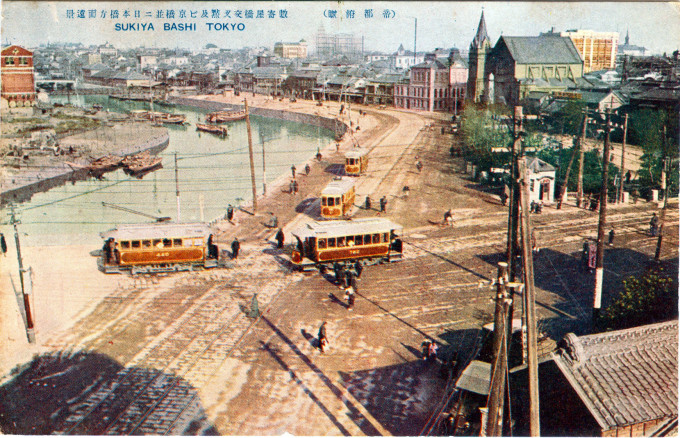
Streetcars crossing the canal at Sukiyabashi, Tokyo, c. 1910, with the newly-consecrated Ginza Methodist Church at upper-right. In the far distance can be seen the towering Dai-Ichi Sogo building at Kyobashi.
See also:
Asashi Shimbun (Newspaper) building, c. 1940, at Sukiyabashi
Aerial Views of Tokyo, c. 1930-1940
Ginza Methodist Church, c. 1915
“A busy canal spanned by several bridges separates Kojimachi Ward from Kyobashi and Ginza, the most prominent of them the Sukiyabashi [tea room bridge] so-named from the circumstance that the district was formerly inhabited by retainers below the rank of samurai whose duty it was to perform the tea ceremony at the Court service. The region roundabout was the one time hunting ground with falcons of the shogun. At present the sound of the hammer saw and mason’s trowel is rarely absent from the locality and each succeeding day adds a bit of change to the fast vanishing Tokio of earlier times.
“The fine new granite structure overlooking the canal here is the Ginza Methodist Church completed and dedicated (by a Japanese pastor) Jan. 19, 1912. It stands on ground valued at ¥40,000 contributed by the Methodist Episcopal Mission; cost ¥32,000 (¥2000 of which was contributed by the Canadian Church Mission); is a power among foreigners as well as Japanese; has an organ that cost ¥6000 and houses the National Temperance Society, a Japanese Language School for foreigners, and other offices.
“Many lines of travel converge at the Sukiyabashi, between which and the Ginza are a number of printing establishment, curio shops, silk merchants, offices of professional and business men, etc. The district has a foreign tinge and English is almost as current as Japanese.”
– Terry’s Japanese Empire, T. Philip Terry, 1914


Pingback: Asahi Shimbun (Newspaper) building, c. 1940, at Sukiyabashi.. | Old Tokyo
Pingback: Ginza Methodist Church, c. 1915 | Old Tokyo